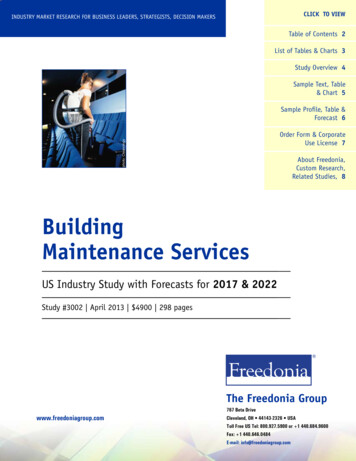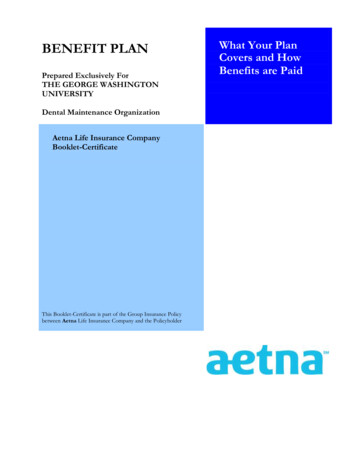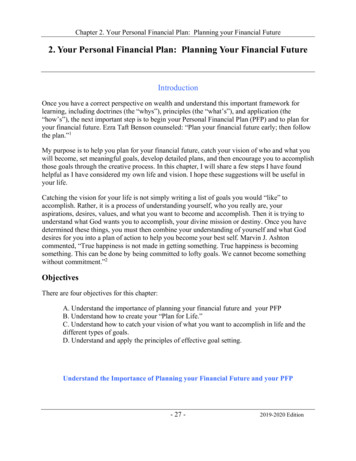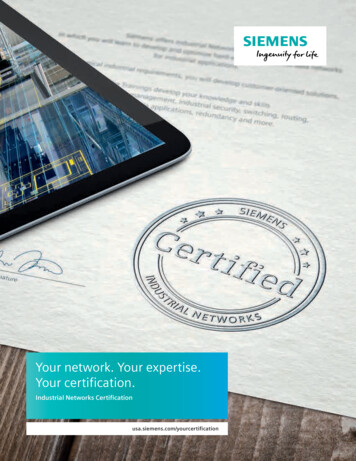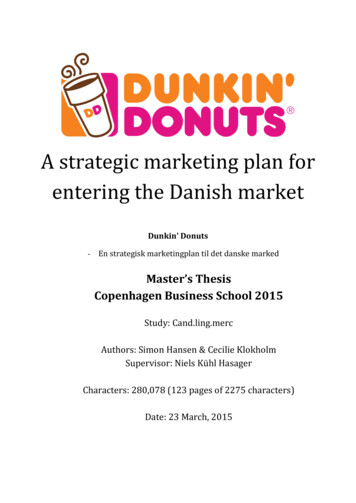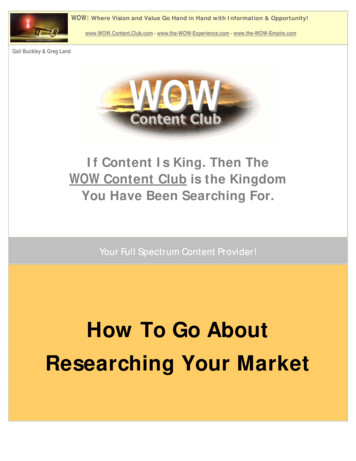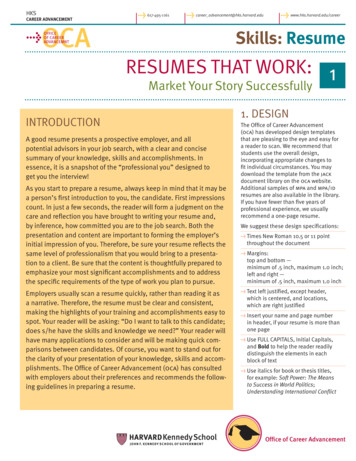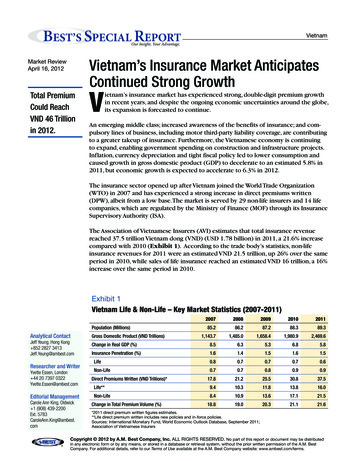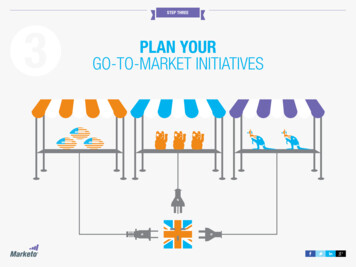
Transcription
Step threePlan YourGo-to-Market Initiatives
Step threePlan YourGo-to-Market Initiatives151. AlignMarketing and sales O nline demo support: Providingemail invitation templates to liveonline demos.While every business and every marketsegment will be different, these are justa selection of the ways that Marketo’smarketing organisation was able tosmooth the path for the local salesteam. (Our sales team also had a lot ofhelp from Marketo Insight, a fantasticdashboard-based tool that lets themsee and focus on the hottest leads formaximum conversions.)Marketing can help sales to helpthemselves in many ways, including:MQLsQLSALsaleslead P rospecting email templates:sample emails that match yourmarketing messages.Recycleprospect &recycled C ompetitor cheat sheets: Detailingcompetitor weak points and waysto win against them. Objection-handling materials:Slides and other content to answerprospects’ FAQs about your productor service. L ead prioritization: Using leadscoring tools to identify the superhot, top-priority leads that are bothready to buy and fit well into yourcompany’s target demographic.leadIn a new market, there are likely tobe many new challenges for sales,including unfamiliar competitors,a target audience who isn’t familiarwith your product or serviceproposition, and new indirect routesto market to. P artner enablement materials:Key messages, templates andcontent to help partners sell.engagedFor each initiative, you’ll wantto set objectives and KPIs beforeyou begin, so you can measureperformance as you go, and tweakany initiatives that aren’t performingas planned. You’ll also want toestablish a local strategy for eachone, to ensure it delivers the bestresults in each country. We’veincluded lots of localisation tipsthroughout this section.The most critical aspect in aligningsales and marketing is to have anagreed understanding of the revenuefunnel and agreed common metricsfor measuring success. Target account profiling: Workingwith sales to identify the top 20-50accounts to pursue, and establishingan account-based marketing planfor each one, augmenting existingknowledge with third-party dataabout each customer to create afuller picture.All namesTwo critical factors: Plan for ROIand adopt an Act Local/ThinkGlobal Strategy.While the primary aim of marketingshould be to generate hot, wellqualified leads to pass to sales forconversion, there are other ways thatyou can help the sales team too.AwarenessThe specific marketing initiativesthat you run in the first 100 dayswill make or break your market entry.While the exact mix of initiatives willbe down to you, we’ve set out belowthe seven concurrent initiativesthat we ran during our internationalexpansion, to give you an idea ofthe gSDRSalescustomer
Step threePlan YourGo-to-Market Initiatives162. Establish yourlocal web presenceBefore you enter any new internationalmarket, you’ll need to plan andestablish your local or regional webpresence. This is likely to mean creatinga dedicated website for each country,localised landing pages and pay-perclick campaigns to drive traffic to yourweb content.The more relevant and accessible youcan make that content to local markets,the more successful you will be. Werecommend carrying out three criticalactivities as soon as you possibly can:1. Register local domainsRegister all the relevant top-levelcountry domain suffixes for yourdomain and keep future expansion inmind as well as the countries you’removing into today.2. Develop local contentDecide your initial go local strategy,whether that’s full website translationand localisation of content, or ‘lighter’sites with links back to your homepagecontent below a certain level. A keyfocus here is to develop local versionsof corporate content that will resonatewith your new market, includinglocalised pricing, customer examples,contact numbers, blogs, etc.“ Of the six billion peoplearound the world, at least70% won’t understand asingle word of English. Ofthe 30% who remain, theymay not speak Englishwell, and may not graspthe full meaning ofmarketing or ad copy.”Zoey Cooper, PostAdvertising, The Importanceof Localization. orlocalisation3. Get optimisingMake sure your sites and content areoptimised for search – and remember,not every country has Google as itsfavourite search engine (see sidebarp18), so make sure your SEO strategytakes account of leading regional andnational search engines too.Go Local tip:Pay-per-click campaigns, landingpages and registration forms willneed to be localised too, to ensurethat searchers in your target countriesare served with relevant content andcontact details, and are able to enterdetails like phone numbers and postalcodes accurately into registrationforms.“ It’s not enough to havea website in the locallanguage and then sit backand expect the traffic andsales to come floodingin. You need to immerseyourself in the localmarket and identify thekey differences betweenthere and your hometurf. These are oftendifferences businessesfind tough to overcome,but the effort will ensurerewards are there.”Chris Bishop, eConsultancy,Seven Tips for GlobaleCommerce
Step threePlan YourGo-to-Market Initiatives17How we do itThe illustration below showshow we rolled out our local webstrategy over the first few weeks.Top 3 Search Engines – GlobalAddition of new local contentas it becomes availableSource: www.netmarketshare.com, April 2012DomainsRegisteredTop 3 Search Engines – ChinaDynamic IP look-upshowing Local phonenumber etcSource: www.netmarketshare.com, April 2012Local PPC Landingpages liveWeek00Top 3 Search Engines – RussiaWeek04Source: www.liveinternet.ru, April 2012
EXPERT VIEW:Getting International SEO RightStep three18Q&ATim GriceTimGriceHead of Search at Branded3,Co-Founder of BabySEOTim has been involved in SEO and the Internet since2004. He spent his early years working as a consultant forclients across Europe and US before becoming head ofsearch for Brand3d, helping global brands succeed online.He also co-founded BabySEO, a company dedicated tohelping small and local businesses make best use ofGoogle to enhance their presence. You can follow himon twitter @Tim Grice.When building out sites in new regions,what is the best approach for a companyto adopt in terms of website structure– TLDs (top-level domains), subfolders,subdomains?The best approach for country-specificperformance is to register the TLDs. In termsof signal strength in Google’s algorithm, thisis by far the strongest factor. However, thesecond best option would be to create a fileunder the root domain targeting each location– which could be implemented as eithersubdomains or subfolders, for example: http://uk.example.com or www.example.com/uk.You can then use Google Webmaster Toolsto geotarget these against the correct region.Personally, I’m not a fan of subdomainsand have always found them to struggle interms of inheriting the authority of the maindomain, but you can still make these workif subdomains were required for certainreasons (e.g. brand, technology, etc.).Are any of these the preferred methodin terms of SEO performance?TLDs seem to hold most weight and theproper use of the hreflang (http://support.google. com/webmasters/bin/answer.py?hl en&answer 189077) can helpauthority pass from the canonical domain.Do any of these affect the click-throughrate from Google, in particular aroundhow user perception of subdomains maydiffer across countries?I haven’t seen any significant evidence tosuggest either type has a higher CTR. The onlyissue I can imagine is that if you have a strongbrand using a subdomain may distract theuser from the brand name.How can a business ensure Google showsthe correct website for each region e.g.the UK site for Google.co.uk, the Frenchsite for Google.fr?Over the past 12 months Google’s beenintroducing a mark-up that they nowunderstand and use to generate listingwithin their index. One of those introductionswas the hreflang tag (http://support.google. com/webmasters/bin/answer.py?hl en&answer 189077) that tells Googlewhich language and country a particular URLshould appear in.Using this along with a TLD/Directory andWebmaster Tools geotargeting is just aboutfool-proof.
EXPERT VIEW:Getting International SEO RightStep threeQ&ATim GriceIf a business targets multipleEnglish-speaking countries – forexample the US, UK, Australia – whatproblems could they encounter fromduplicating their core site for otherregions? Will Google penalize them?There’s a chance rolling out duplicatesites in different locations will harmyour rankings across all sites.However an easy way to prevent thisis by implementing the hreflang tag(above) along with a canonical linkback to your master domain. The bestimplementation I’ve seen of this islaptopsdirect.co.uk.For companies who use theirblog as a source of inbound trafficfrom Google, do you feel there’sa benefit in having a blog for eachregion they target or simply using theone blog to post regional content?It depends on the industry. However,blogs are to be used to help establishyour website/ business as the authorityin any particular industry. As long asthe fundamentals of the business arethe same internationally then you cansimply translate your blog posts andsplit it into regions.Again, the hreflang can be implementedto help users detect the right content.What are the biggest mistakesyou see companies make whenimplementing an internationalSEO strategy?The main mistake is probably thetargeting, especially across samelanguage countries. People presumebecause countries speak the samelanguage their site should automaticallyrank in that country, for example, .comfor the UK and US.The other big mistake comes when linkbuilding, you need links from websitesin the same country. However, a lot ofSEOs take the easy option and buildlinks from English-speaking sites toGerman/French sites, etc.How important is your technicalinfrastructure in terms ofinternational SEO? In particular yourCMS and translation workflows?Your CMS should have the abilityto enable different language versions,with a relevant optimised URL and aneasy implementation of the hreflang.If you could leave us with onetip for international SEO success,what would it be?Use hreflang to help Googledifferentiate between your differentregional websites.19
Step threePlan YourGo-to-Market Initiatives203. Events:Go Where They GoA web presence is all very well, but ifyou really want to make a splash withyour new target audience, you’ll alsoneed to go where they are going.Participating in relevant events –whether a third party’s or hostingyour own – is a great way ofmeeting a lot of people face-toface, gathering names for yourmarketing funnel, and starting tobuild relationships with prospectivebuyers. At the same time, events canbe a significant drain on resources,so it’s a good idea to draw on otherlocal teams to help with key activitiesbefore, during and after the event.While the exact mix of events willdepend on your target audience,objectives, and budget, it’s likelythat you’ll want a mixture of big andsmall events across the followingevent types:Own events:The events that you organise andmanage for your own brand.Pros: You control the content, havea captive audience, and can dedicateas much time as you like to your ownproducts and messaging.Cons: In a new market, you may nothave the brand recognition, contactsor marketing resource to attract enoughdelegates of the right calibre. You mayinvest a lot of budget for little return.Industry trade shows:Pros: More cost-effective thanorganising your own events. Large,relevant audiences are generallyguaranteed.Cons: You must compete for attentionwith all of the other speakers andexhibitors. Delegates are not usuallyin active buying mode, so prospectsmay take a long time and a lot of effortto convert.Analyst events:Events organised by industry analyststo explore a single hot topic or currenttrends in a given area.Pros: Can attract a targeted audienceof senior decision-makers,Cons: You can’t control the advice theanalysts give – and it might not alignwith your own story!Partner events:Events organised by your businesspartners for their customers andprospects.Pros: More cost-effective thanorganising your own events, with a highproportion of potential customers inattendance.Cons: Less airtime for your ownproducts and services than with yourown events.Create a database of relevant events foryour first 100 days, listing the criteriathat matter to you: number of expecteddelegates, delegate profile, cost toexhibit, cost to speak, cost to sponsor,etc. From this you can prioritise theevents that deliver the most value forthe available budget, and create anevent marketing plan and calendar thatmaximises your available budget.Once you have your events plan,you can get to work developingyour content, designing your stand,training your events team, identifyingsuitable spokespeople and topics, andreaching out to attending delegatesand journalists via social media. So thatwhen each event rolls around, you’reready to just push the button and go.Go Local tips:Ensure any supporting materialsare translated into relevantlanguages in time for each event.For non-English-speaking audiences,identify speakers who can deliverpresentations in local language.Subtitling into English can be avery cost-effective way of repurposingvideo footage from local-languageevents for a wider audience, as wellas improving its online searchability.Remember your pre-event activityand post-event follow-up are equallyif not more important that what youdo on-site. See the Marketo eventsguide for more best practice here.
Step threePlan YourGo-to-Market Initiatives21How we do itHow we got 200 people to our firstMarketo event in EuropeEvents are an important part of anymarket entry. They’re a great way tointeract with customers and prospects,to turn mild interest into real leads andto build your brand.But our own program analysistells us that events can be an expensiveway to generate leads – if that’s allyou want to do. Add in the customerinteraction goal, though, and it’s hardto beat a live event. And when you runyour own, the entire audience is yoursfor the duration.Here are our lessons from our firstRevenue Rockstar event in London:Set the goals up front – forattendance, target audience andrevenue impact.Pick the right theme, content andformat – Our ‘Revenue Rockstar Tour’helped generate buzz and told peoplethis was going to be about the bottomline. We then built the day aroundcustomer sessions, thought-leadingkeynotes, customer stories – and ahappy hour to wrap things up.Use a multi-touch promotional plan –We used a “big bang” launch followedby individual invitations timed threeweeks, one week and two days out,plus reminders by email and phone.Segment the data – We invested alot of time and effort getting the listsright and the data clean, using our owndemographic scoring (and locationdata) to ensure we were inviting theright people.Follow up quickly after the event –We sent CDs full of content right awayand followed up with the presentationslides after, along with a delegatesurvey. (And make sure the sales teamknows who attended!)Spin-off your large events – Wecomplemented our large RevenueRockstar event with a series of smallerRevenue Rockstar-Unplugged events(one per month).Scale, leverage and automate – Onceyou’ve got an event template, re-usethe programme for future events. Wewere able to leverage similar US events,cloning and localising the automatedprogram flows.Measure everything – Measuringis in our DNA, so we tracked ROI bylooking at numbers invited, registeredand attended; quality and buying stageof attendees; and new opportunitiescreated by the event.“ Event marketing accountsfor one fifth of marketingbudgets.”BtoB Magazine, State of EventMarketing, July 2011
Step threePlan YourGo-to-Market Initiatives22How we do itHere’s the timeline we used toplan our events schedule in ourfirst 100 days, featuring a mixtureof our own Revenue Rockstarand Rockstar Unplugged events;partner events such as Salesforce.com’s Dreamforce and Cloudforce;and analyst and industry eventsorganised by Sirius Decisions.Revenue Rockstartour unpluggedSiriusDecisions SummitRevenue Rockstartour unpluggedRevenue Rockstartour berRevenue Rockstarand User GroupNovember
Step threePlan YourGo-to-Market Initiatives234. Buildthe DatabaseThe most important thing you can doin the first days of entering any newmarket is to start building a soliddatabase of leads and prospects.Here at Marketo, we’re pretty stricton what constitutes a lead (seesidebar), so we prefer to think of theinitial name-gathering exercise as justthat: gathering names to put into thetop of your marketing funnel. What’simportant is that you start gettingthose names in there as soon aspossible, then use lead-scoring andlead-nurturing tools to start turningthem into engaged, interested partieswho are willing to buy from you.(For best practice in lead scoring andlead nurturing, read our Definitive Guideto Lead Scoring and Definitive Guide toLead Nurturing.)So how do you go about gettingthose names into the database?You’ll undoubtedly have an armouryof demand-generation tactics at yourdisposal already, but here are some ofthe ways we started building and usingour EMEA database:Webinars:Webinars are a great opportunity toengage with local thought leaders andincrease your influence in the regionby presenting on hot topics together.These influencers will promote thewebinar to their community to helpdrive awareness and attendance.Third-party email broadcasts:Promoting your content via relevantand established email blasts sent outby local publishers, media companiesand other third parties. These shouldlink back to a landing page of yourown, so you can capture basic contactdetails for your database.Marketo example:We partnered with Tamara Gielenof Plan to Engage to present aregionally-focused webinar on B2BEmail Marketing and Lead NurturingTrends for 2012. The webinar attracted140 attendees, of whom 108 are nowscored as prospects in our database.Go Local tip:Offering content that is localised(both in terms of language andrelevance to the target market) willresonate better and lead to muchbetter download rates.Go Local tip:If you’ve got a great webinar schedulein another time zone, there may be anopportunity to repurpose that contentby running a similar webinar in the righttime zone or simply promoting theoriginal webinar recording if the topicand language are right for your newtarget audience.When is a Lead not a Lead?At Marketo we score all incomingleads using a combination ofdemographics, lead sourceinformation and behavioralscores. Demographics deliver ascore between 0 and 30 points.From there, each behavior isassigned a point value, from 1point for a web page visited andemail opened to 15 points forsearching for ‘Marketo’on Google.Qualified leads with fewer than 65points are called ‘Prospects’ andreceive further nurturing. Thosewith over 65 points are called‘Leads’ and are sent to telesalesfor further qualification.
Plan YourGo-to-Market InitiativesMaking sure you have a great leadnurture program in place will beessential to getting the most from yourdatabase. Great lead nurturing will turnmore names into qualified leads andeventual sales. Your sales team willalso have better sales conversations,as prospects are educated throughautomated lead nurture campaignsthat score them both on behaviorand demographics.Content syndication:Making your content available onrelevant third-party websites your targetaudience is already visiting.Marketo example:We syndicated content including whitepapers, webinars and Definitive Guidesto popular local marketing publications(see right).Step threeEmail marketing:Outbound nurturing emails to engagedprospects already in the marketingdatabase, promoting relevant newcontent and offers. A goo
qualified leads to pass to sales for conversion, there are other ways that you can help the sales team too. The most critical aspect in aligning sales and marketing is to have an agreed understanding of the revenue . tiM grice heaD oF searCh at BranDeD3, Co-FounDer

